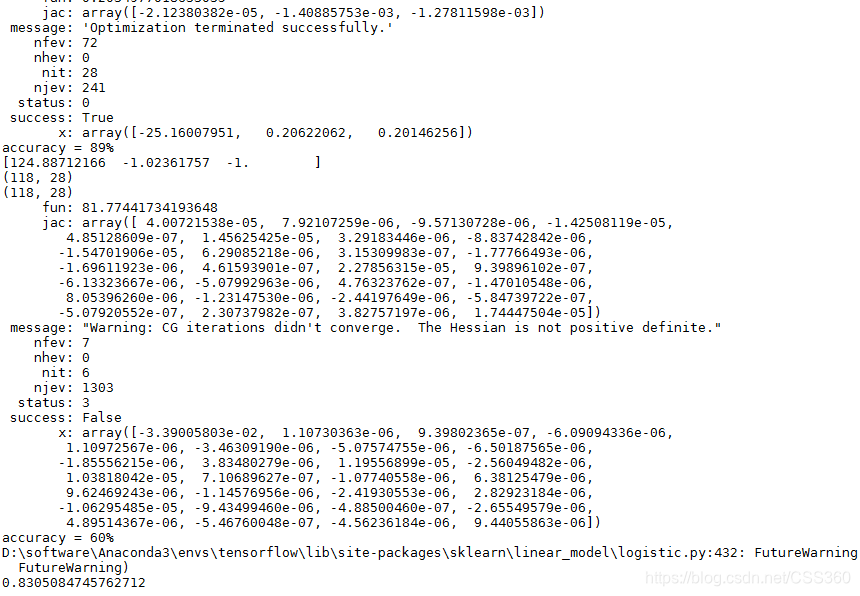1、资料搜集
机器学习之正则化(Regularization)(读者反馈很好)
正则化详解机器学习中的正则化(Regularization)(读者反馈很好)
深度学习中的正则化技术(附Python代码) (理论+实现)
吴恩达机器学习课程笔记+代码实现(9)Python实现逻辑回归和正则化(Programming Exercise 2)
2、本人总结
我们还是先思考一个问题,为什么会出现正则化这个名词。我们在讲解最小二乘法的时候,会遇到过拟合(又叫“高方差”)的现象。简单说过拟合现象,使用高维函数进行数据拟合时,为了使误差达到最下,拟合后的函数对当前训练数据误差比较小。但是当新的数据加入的时候,拟合的函数性能表现很差。在这里说到过拟合,就不得不说一下欠拟合(又叫“高偏差”)。欠拟合其实就是我们假设的函数模型是低维,在根据数据进行拟合的时候,不能很好得到数据本质特性。
图一(上下两张第一幅图)表现出来的就是“欠拟合”现象,我们可以看到后面的数据开始趋于平缓,而我们使用一维函数拟合的结果,后面数据呈现上升的趋势;
图二(上下两张第二幅图)是非常正确的表达了数据所表示的模型;
图三(上下两张第三幅图)则就是“过拟合”线性,拟合的函数为了适应数据,所有的函数都经过了训练数据,对新数据表现性能会很差;
那么我们如何解决过拟合这个现象呢,主要有两种方法:尽量减少选取变量的数量;加入正则化。其中减少选取变量的数量,说白了就是我们人为经过对数据进行分析,将一些对判定结果不重要的特征信息去除,来达到减少变量数量目的。但是这样也会造成模型假设的不精确,例如,我们要拟合一下每天进出北京车的数量,由于出现过拟合,我们可能认为河北、天津等北京周边信息对解决该问题的意义不是很大,而删除该特征信息。但是有的时候确实会存在,周边地区政策或者其它原因,导致进出北京车辆的数目增加。因此,删除该特征信息,会造成降低模型的精确度。说了那么多第一种方法,就让我详细说一下正则化方法吧。
2.1 概念
正则化又称为规则化、权重衰减技术,在不同的方向上有不同的叫法,在数学中叫做范数。例如L1和L2范数,统计学领域叫做惩罚项、罚因子,以信号降噪为例:
其中,x(i)为原始信号,或者是小波或者傅里叶等系数,R(x(i))则为惩罚函数,是正则项,y(i)是传感器采集到含噪声的信号,I = {0, ..., N - 1},其中N为信号点,
为降噪后输出。在图像中公式也是类似的。
在这里给出范数的数学公式,其实就是公式的一种叫法,像我们经常用到的所有变量绝对值求和就是L1范数。所以其实大家都很熟悉,不要听范数就开始有点懵。
(1)P范数:
(2)L0范数:表示向量中非零元素的个数(即为稀疏度)
(3)L1范数:
(4)L2范数:
(5)无穷范数:所有向量元素绝对值最大值
(6)负无穷范数:所有向量元素绝对值最小值
向量长度为2维,下图的表示
向量长度为3维,则表示为下图:
从上图可以看到P值越小则越贴近坐标轴,当P值越大时菱角越明显。因此, 不同的范数会对应不同的特性,我们在使用的时候需要根据具体情况进行选择。
2.2 公式推导
在线性回归的求解过程,我们一般运用两种方法,一种基于梯度下降方法,一种基于正规方程。首先我们先引入一个正则化方程:,其中
(1)梯度下降方法
因为我们在进行正则化的时候,一般会去掉第0项,所以
对于j从1到m项的偏导数:
因此,每个变量的更新方式为:以及
(2)正则方程
将问题转化为矩阵形式:
其中优化的是
我们在最小二乘中,已经退到过矩阵的运算的方法,具体看链接。但这里多了一项正则项,所以方程转化为:
我们知道在样本较少的情况下,导致特征数量大于样本数量,那么矩阵是不可逆或者说矩阵是退化矩阵,但是通过加入正则化后,可以证明矩阵
是完全可逆的。因此,通过加入正则化,就可以在相对较小的训练集里有很多特征情况下,来实现数据拟合。
2.3 代码实现
上面讲了很多理论知识,下面直接上代码出结果。代码中要用到的相关数据,请在此链接中下载,或者自行下载吴恩达老师机器学习课程中公布的数据。
(1)源代码
import numpy as np
import pandas as pd
import matplotlib as mpl
import matplotlib.pyplot as plt
import seaborn as sns
sns.set(style="whitegrid",color_codes=True)
#样本训练数据为申请入学的学生两次测评的成绩,以及最后是否被录取的结果。
data = pd.read_csv('ex2data1.txt', header=None, names=['Exam 1', 'Exam 2', 'Admitted'])
data.head()
positive = data[data['Admitted'].isin([1])]
negative = data[data['Admitted'].isin([0])]
#数据可视化
#创建两个分数的散点图,并使用颜色编码来可视化,如果样本是正的(被接纳)或负的(未被接纳)
fig, ax = plt.subplots(figsize=(10,6))
ax.scatter(positive['Exam 1'], positive['Exam 2'], s=50, c='b', marker='o', label='Admitted')
ax.scatter(negative['Exam 1'], negative['Exam 2'], s=50, c='r', marker='x', label='Not Admitted')
ax.legend()
ax.set_xlabel('Exam 1 Score')
ax.set_ylabel('Exam 2 Score')
#sigmoid 函数
def sigmoid(z):
return 1 / (1 + np.exp(-z))
nums = np.arange(-10, 10, step=0.01)
fig, ax = plt.subplots(figsize=(8,6))
ax.plot(nums, sigmoid(nums), 'r')
#代价函数:
def cost(theta, X, y):
theta = np.matrix(theta)
X = np.matrix(X)
y = np.matrix(y)
first = np.multiply(-y, np.log(sigmoid(X * theta.T)))
second = np.multiply((1 - y), np.log(1 - sigmoid(X * theta.T)))
return np.sum(first - second) / (len(X))
#对数据稍作处理,同exercise1
# add a ones column - this makes the matrix multiplication work out easier
data.insert(0, 'Ones', 1)
# set X (training data) and y (target variable)
cols = data.shape[1]
X = data.iloc[:,0:cols-1]
y = data.iloc[:,cols-1:cols]
# convert to numpy arrays and initalize the parameter array theta
X = np.array(X.values)
y = np.array(y.values)
theta = np.zeros(3)
#计算一下初始化参数的cost
cost(theta, X, y)
#gradient descent(梯度下降)
def gradient(theta, X, y):
theta = np.matrix(theta)
X = np.matrix(X)
y = np.matrix(y)
parameters = int(theta.ravel().shape[1])
grad = np.zeros(parameters)
error = sigmoid(X * theta.T) - y
for i in range(parameters):
term = np.multiply(error, X[:,i])
grad[i] = np.sum(term) / len(X)
return grad
#使用 scipy.optimize.minimize 去拟合参数
import scipy.optimize as opt
res = opt.minimize(fun=cost, x0=theta, args=(X, y), method='Newton-CG', jac=gradient)
print(res)
#预测与验证
def predict(theta, X):
probability = sigmoid(X * theta.T)
return [1 if x >= 0.5 else 0 for x in probability]
final_theta =np.matrix(res.x)
predictions = predict(final_theta, X)
correct = [1 if ((a == 1 and b == 1) or (a == 0 and b == 0)) else 0 for (a, b) in zip(predictions, y)]
accuracy = (sum(map(int, correct)) % len(correct))
print ('accuracy = {0}%'.format(accuracy))
#寻找决策边界
coef = -(res.x / res.x[2]) # find the equation
print(coef)
positive = data[data['Admitted'].isin([1])]
negative = data[data['Admitted'].isin([0])]
fig, ax = plt.subplots(figsize=(10,6))
ax.scatter(positive['Exam 1'], positive['Exam 2'], s=50, c='b', marker='o', label='Admitted')
ax.scatter(negative['Exam 1'], negative['Exam 2'], s=50, c='r', marker='x', label='Not Admitted')
ax.legend()
ax.set_xlabel('Exam 1 Score')
ax.set_ylabel('Exam 2 Score')
x = np.arange(30,100, step=0.1)
y = coef[0] + coef[1]*x
plt.plot(x, y, 'grey')
'''
第二部分:逻辑回归+正则化
说明:这部分也要用到上一部分中的函数,所以要一起运行
'''
#正则化逻辑回归
data2 = pd.read_csv('ex2data2.txt',header=None,names = ['test1','test2','accepted'])
data2.head()
positive = data2[data2['accepted'].isin([1])]
negative = data2[data2['accepted'].isin([0])]
fig, ax = plt.subplots(figsize=(8,6))
ax.scatter(positive['test1'], positive['test2'], s=50, c='b', marker='o', label='tccepted')
ax.scatter(negative['test1'], negative['test2'], s=50, c='r', marker='x', label='rejected')
ax.legend()
ax.set_xlabel('Test1 Score')
ax.set_ylabel('Test2 Score')
#feature mapping(特征映射)
def feature_mapping(x, y, power, as_ndarray=False):
data = {"f{}{}".format(i - p, p): np.power(x, i - p) * np.power(y, p)
for i in np.arange(power + 1)
for p in np.arange(i + 1)
}
if as_ndarray:
return pd.DataFrame(data).as_matrix()
else:
return pd.DataFrame(data)
x1 = np.array(data2.test1)
x2 = np.array(data2.test2)
d = feature_mapping(x1, x2, power=6)
print(d.shape)
d.head()
# set X and y (remember from above that we moved the label to column 0)
cols = d.shape[1]
X2 = d.iloc[:,0:cols]
y2 = data2.iloc[:,-1]
# convert to numpy arrays and initalize the parameter array theta
X2 = np.array(X2.values)
y2 = np.array(y2.values)
theta2 = np.zeros(d.shape[1])
print(X2.shape)
#regularized cost(正则化代价函数)
def regularized_cost(theta, X, y, l = 1):
# '''you don't penalize theta_0'''
theta_j1_to_n = theta[1:]
regularized_term = (l / (2 * len(X))) * np.power(theta_j1_to_n, 2).sum()
return cost(theta, X, y) + regularized_term
#正则化代价函数
regularized_cost(theta2, X2, y2)
#regularized gradient(正则化梯度)
def gradientReg(theta, X, y, l = 1):
theta = np.matrix(theta)
X = np.matrix(X)
y = np.matrix(y)
parameters = int(theta.ravel().shape[1])
grad = np.zeros(parameters)
error = sigmoid(X * theta.T) - y
for i in range(parameters):
term = np.multiply(error, X[:,i])
if (i == 0):
grad[i] = np.sum(term) / len(X)
else:
grad[i] = (np.sum(term) / len(X)) + ((l/ len(X)) * theta[:,i])
return grad
gradientReg(theta2,X2,y2,l=1)
#使用 scipy.optimize.minimize 去拟合参数
import scipy.optimize as opt
#print('init cost = {}'.format(regularized_cost(theta, X2, y2)))
res = opt.minimize(fun=regularized_cost, x0=theta2, args=(X2, y2), method='Newton-CG', jac=gradientReg)
print(res)
theta_min =np.matrix(res.x)
predictions = predict(theta_min, X2)
correct = [1 if ((a == 1 and b == 1) or (a == 0 and b == 0)) else 0 for (a, b) in zip(predictions, y2)]
accuracy = (sum(map(int, correct)) % len(correct))
print ('accuracy = {0}%'.format(accuracy))
#调用sklearn的线性回归包
from sklearn import linear_model
model = linear_model.LogisticRegression(penalty='l2', C=1.0)
model.fit(X2, y2.ravel())
linear_model.LogisticRegression(C=1.0, class_weight=None, dual=False, fit_intercept=True,
intercept_scaling=1, max_iter=100, multi_class='warn',
n_jobs=None, penalty='l2', random_state=None, solver='warn',
tol=0.0001, verbose=0, warm_start=False)
print(model.score(X2, y2))
(2)实验结果

(3)关键部分详细讲解
数据分布
data = pd.read_csv('ex2data1.txt', header=None, names=['Exam 1', 'Exam 2', 'Admitted'])
data.head()

数据可视化

Sigmoid函数
一般我们比较常见的Sigmoid函数为:,在这里我们假设函数为
def sigmoid(z):
return 1 / (1 + np.exp(-z))

损失函数(关于此函数怎么来的请看链接)
def cost(theta, X, y):
theta = np.matrix(theta)
X = np.matrix(X)
y = np.matrix(y)
first = np.multiply(-y, np.log(sigmoid(X * theta.T)))
second = np.multiply((1 - y), np.log(1 - sigmoid(X * theta.T)))
return np.sum(first - second) / (len(X))
gradient descent(梯度下降)
在这里使用批量梯度下降方法,并将其转化为向量方法,则转化为
#计算一个梯度步长
def gradient(theta, X, y):
theta = np.matrix(theta)
X = np.matrix(X)
y = np.matrix(y)
parameters = int(theta.ravel().shape[1])
grad = np.zeros(parameters)
error = sigmoid(X * theta.T) - y
for i in range(parameters):
term = np.multiply(error, X[:,i])
grad[i] = np.sum(term) / len(X)
return grad
第二部分:正则化逻辑回归
数据格式

数据可视化

feature mapping(特征映射)
def feature_mapping(x, y, power, as_ndarray=False):
data = {"f{}{}".format(i - p, p): np.power(x, i - p) * np.power(y, p)
for i in np.arange(power + 1)
for p in np.arange(i + 1)
}
if as_ndarray:
return pd.DataFrame(data).as_matrix()
else:
return pd.DataFrame(data)
特征映射对应的数据:

regularized cost(正则化代价函数)
def regularized_cost(theta, X, y, l = 1):
# '''you don't penalize theta_0'''
theta_j1_to_n = theta[1:]
regularized_term = (l / (2 * len(X))) * np.power(theta_j1_to_n, 2).sum()
return cost(theta, X, y) + regularized_term
#正则化代价函数
regularized gradient(正则化梯度)
def gradientReg(theta, X, y, l = 1):
theta = np.matrix(theta)
X = np.matrix(X)
y = np.matrix(y)
parameters = int(theta.ravel().shape[1])
grad = np.zeros(parameters)
error = sigmoid(X * theta.T) - y
for i in range(parameters):
term = np.multiply(error, X[:,i])
if (i == 0):
grad[i] = np.sum(term) / len(X)
else:
grad[i] = (np.sum(term) / len(X)) + ((l/ len(X)) * theta[:,i])
return grad
